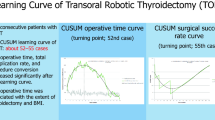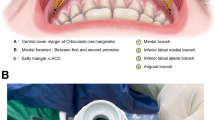Abstract
Background
Single-incision, transaxillary, robotic-assisted (STAR) thyroid lobectomy using a robotic surgical system is a novel surgical approach that is extensively described in Korean patients. Some have suggested that this experience will not translate into the American population because of differing body habitus and because the mean size of the thyroid nodules removed in Korea are <1 cm. We reviewed our experience with STAR thyroid lobectomy.
Methods
We retrospectively reviewed our prospectively collected data on consecutive cases of STAR thyroid lobectomy performed by a single surgeon. Operative times and patient outcomes were evaluated.
Results
Seventeen operations were performed on 15 patients. Mean total operative time was 219.3 (range, 183–256) minutes. All patients were discharged on postoperative day 1. Postoperative complications were seromas (n = 2) and cellulitis (n = 2). Operative time did not vary with the size or volume of the nodule or gland. The mean nodule diameter was 1.9 (range, 0.5–3.1) cm. The mean nodule volume and thyroid volume were 5.0 (range, 0.1–16.7) cm3 and 20.7 (range, 11.8–45.8) cm3, respectively. When stratified by body mass index (range, 19.6–37.8), normal versus overweight or obese, total operative time increased from 204 to 225 min, and console time from 114 to 125 min.
Conclusions
STAR thyroid surgery is a feasible technique. Factors, such as mass size, specimen volume, and patient body mass index, had little effect on operative times. These differences should not hinder the adoption of this procedure in North America, because new retractor systems help to overcome them. Further evaluation of this procedure is reasonable and safe.




Similar content being viewed by others
References
Huscher CS, Chiodini S, Napolitano C, Recher A. Endoscopic right thyroid lobectomy. Surg Endosc. 1997;11(8):877.
Miyano G, Lobe TE, Wright SK. Bilateral transaxillary endoscopic total thyroidectomy. J Pediatr Surg. 2008;43(2):299–303.
Kang SW, Lee SC, Lee SH, et al. Robotic thyroid surgery using a gasless, transaxillary approach and the da Vinci S system: the operative outcomes of 338 consecutive patients. Surgery. 2009;146(6):1048–55.
Kang SW, Jeong JJ, Yun JS, et al. Robot-assisted endoscopic surgery for thyroid cancer: experience with the first 100 patients. Surg Endosc. 2009;23(11):2399–406.
Kang SW, Jeong JJ, Nam KH, Chang HS, Chung WY, Park CS. Robot-assisted endoscopic thyroidectomy for thyroid malignancies using a gasless transaxillary approach. J Am Coll Surg. 2009;209(2):e1–7.
Lewis CM, Chung WY, Holsinger FC. Feasibility and surgical approach of transaxillary robotic thyroidectomy without CO(2) insufflation. Head Neck. 2010;32(1):121–6.
Lee J, Yun JH, Nam KH, Soh EY, Chung WY. The learning curve for robotic thyroidectomy: a multicenter study. Ann Surg Oncol. 2010;3:3.
Lee J, Yun JH, Nam KH, Choi UJ, Chung WY, Soh EY. Perioperative clinical outcomes after robotic thyroidectomy for thyroid carcinoma: a multicenter study. Surg Endosc. 2010;24:24.
Lee J, Nah KY, Kim RM, Ahn YH, Soh EY, Chung WY. Differences in postoperative outcomes, function, and cosmesis: open versus robotic thyroidectomy. Surg Endosc. 2010;19:19.
Ryu HR, Kang SW, Lee SH, et al. Feasibility and safety of a new robotic thyroidectomy through a gasless, transaxillary single-incision approach. J Am Coll Surg. 2010;211(3):e13–9.
Landry CS, Grubbs EG, Stephen Morris G, et al. Robot assisted transaxillary surgery (RATS) for the removal of thyroid and parathyroid glands. Surgery. 2010;12:12.
Landry CS, Grubbs EG, Perrier ND. Bilateral robotic-assisted transaxillary surgery. Arch Surg. 2010;145(8):717–20.
Berber E, Heiden K, Akyildiz H, Milas M, Mitchell J, Siperstein A. Robotic transaxillary thyroidectomy: report of 2 cases and description of the technique. Surg Laparosc Endosc Percutan Tech. 2010;20(2):e60–3.
Kuppersmith RB, Holsinger FC. Robotic thyroid surgery: an initial experience with North American patients. Laryngoscope. 2011;121(3):521–6.
Perrier ND, Randolph GW, Inabnet WB, Marple BF, VanHeerden J, Kuppersmith RB. Robotic thyroidectomy: a framework for new technology assessment and safe implementation. Thyroid. 2010;20(12):1327–32.
Mottura AA, Del Castillo R. Transaxillary breast augmentation: two breast cancer patients with successful sentinel lymph node diagnosis. Aesthetic Plast Surg. 2007;31(5):544–9; discussion 550–2.
Sado HN, Graf RM, Canan LW, et al. Sentinel lymph node detection and evidence of axillary lymphatic integrity after transaxillary breast augmentation: a prospective study using lymphoscintigraphy. Aesthetic Plast Surg. 2008;32(6):879–88.
Acknowledgment
This work was supported in part by a Building Interdisciplinary Research Careers in Women’s Health (BIRCWH) grant (1K12HD0555181-04) from the National Institutes of Health.
Author information
Authors and Affiliations
Corresponding author
Rights and permissions
About this article
Cite this article
Stevenson, C.E., Gardner, D.F. & Grover, A.C. Patient Factors Affecting Operative Times for Single-incision Trans-Axillary Robotic-assisted (STAR) Thyroid Lobectomy: Does Size Matter?. Ann Surg Oncol 19, 1460–1465 (2012). https://doi.org/10.1245/s10434-011-1972-0
Received:
Published:
Issue Date:
DOI: https://doi.org/10.1245/s10434-011-1972-0




